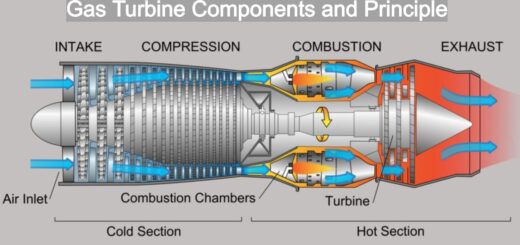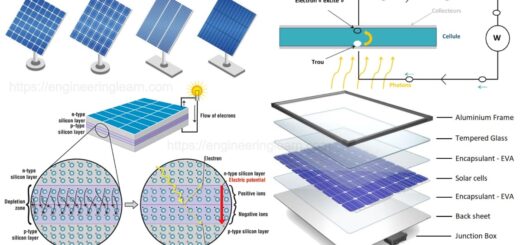How do Solar Panel Work? [Explained]
![How do Solar Panel Work? [Explained]](https://engineeringlearn.com/wp-content/uploads/2023/04/How-do-Solar-Panel-Work-1024x539.jpg)
Introduction
How do Solar Panel Work? [Explained]: – Solar energy works by capturing the sun’s energy discreetly as well as effectively transforming it into electricity for your home or business. Solar doesn’t produce electricity constantly, however, it does generate electricity when it is required the most. This includes or incorporates during the daytime and during hot radiant periods when demand for electricity is essential for both individuals as well as industries. If we talk about today’s solar panels and complete solar panel systems are utilized to drive a wide variety of applications. Numerous solar panels are utilized as solar cells which are being utilized in calculators.
What is a Solar Panel?
Solar panels are those devices or gadgets which are utilized to retain the sun’s rays and convert them into heat or electricity. A solar panel is actually a collection of solar cells, which can be utilized to generate electricity through photovoltaic impact. Switching or Changing to solar energy enjoys many benefits, permitting you to set aside cash while helping the environment, and may have a couple of impediments connected to the position of your home and weather patterns. Utilizing solar panels you can convert sunlight, which is free and boundless, into electricity. This change is accomplished thanks to the “semiconductor” material from which each solar cell is made.
Utilizing solar panels is an exceptionally reasonable method for producing electricity for many applications. The obvious would need to be off-grid living. Living off-grid implies living in an area that isn’t serviced by the main electric utility grid. Remote homes and cabins benefit pleasantly from solar power systems. Never again is it important to pay enormous charges for the installation of electric utility poles and cabling from the nearest principal grid access point.
Solar panels respond to the noticeable light spectrum. This implies, on the off chance that it has an adequate light to see, there’s sufficient light for them to generate electricity. Be that as it may, the stronger the sunlight the more power solar panels will generate. On any type of building, road, bridge, and even spacecraft and satellites solar panels can be utilized. Lightweight, portable panels are now present on solar blinds for your windows and little gadgets like phone chargers which indicates that solar energy is advancing into all parts of life.
How do Solar Panel Work?
Photovoltaic (PV) solar panels are comprised of numerous solar cells in different kinds of glass packaging. They are constructed or built with both positive and negative layers, which creates an electric field together, a lot like in a battery. Sun-power solar panels are additionally encased with aviation-grade conductive adhesives and minimize encapsulates to shield these cells and limit degradation from ecological exposure. Right when photons hit a solar cell, they knock or thump electrons free or loose from their atomic molecules.
On the off chance that conductors are attached or connected to the positive sides as well as the negative sides of a cell, an electrical circuit is formed. Exactly when electrons flow through such a circuit, electricity is generated. Numerous cells make up a solar panel, and various panels (modules) can be wired together to frame a solar array. The more panels you can deploy or convey, the more energy you can expect to generate.
This is an illustration of the way a home solar energy installation works. To begin with, sunlight hits a solar panel on the rooftop. When the energy is converted to DC current from the panel, which further flows to an inverter. The inverter converts the electricity from DC over completely to AC, which you can then use to power your home. It’s flawlessly simple and clean, and it’s getting more productive and affordable all the time.
Nonetheless, what happens on the off chance that you’re not home to utilize the electricity your solar panels are generating every sunny day? Furthermore, what happens around nighttime when your solar system isn’t generating power continuously? You just need to simply sit back and relax, you may likewise have the option to benefit from a system called “feed-in tariffs” contingent upon your state and energy retailer.
A typical grid-tied PV system during peak daylight hours frequently produces more energy than one customer actually needs, so excess or overabundance of energy is taken care of once more into the grid for use somewhere else. The user gets credit for the excess energy produced, and he can further use that credit to draw from the conventional grid around nighttime or even on cloudy days. A ‘feed-in tariff’ is the rate at which you really ‘sell’ your solar-produced power, once more back into the grid.
Conclusion
Installation of solar panels in homes helps in combating the harmful emissions of ozone gases and in this manner lessens global warming. Solar panels lead to no type of pollution and are clean. They additionally decrease our reliance on fossil fuels(which are restricted) and traditional power sources. These days, Solar panels are utilized in colossal electronic equipment like calculators, which fill in for however long as sunlight is available. Most solar panels are made up utilizing crystalline silicon solar cells. With regards to wear-and-tear, these panels are areas exceptionally strong.
Solar panels wear out extremely low. In a year, their viability diminishes something like one to two percent (on occasion, even lesser). Solar panels are extremely safe. They’re for the most part made utilizing silicon sheets, and there’s no risk of the photovoltaic cells leaking or releasing as well as emitting any exhaust or poisons. They make no noise pollution while generating electricity. This implies that installations aren’t intrusive or meddlesome – whether they’re in jam-packed metropolitan locations or quiet rural ones.
Content Source: – sunpower
Image Source: – sunlightsolar, renewablesinafrica













